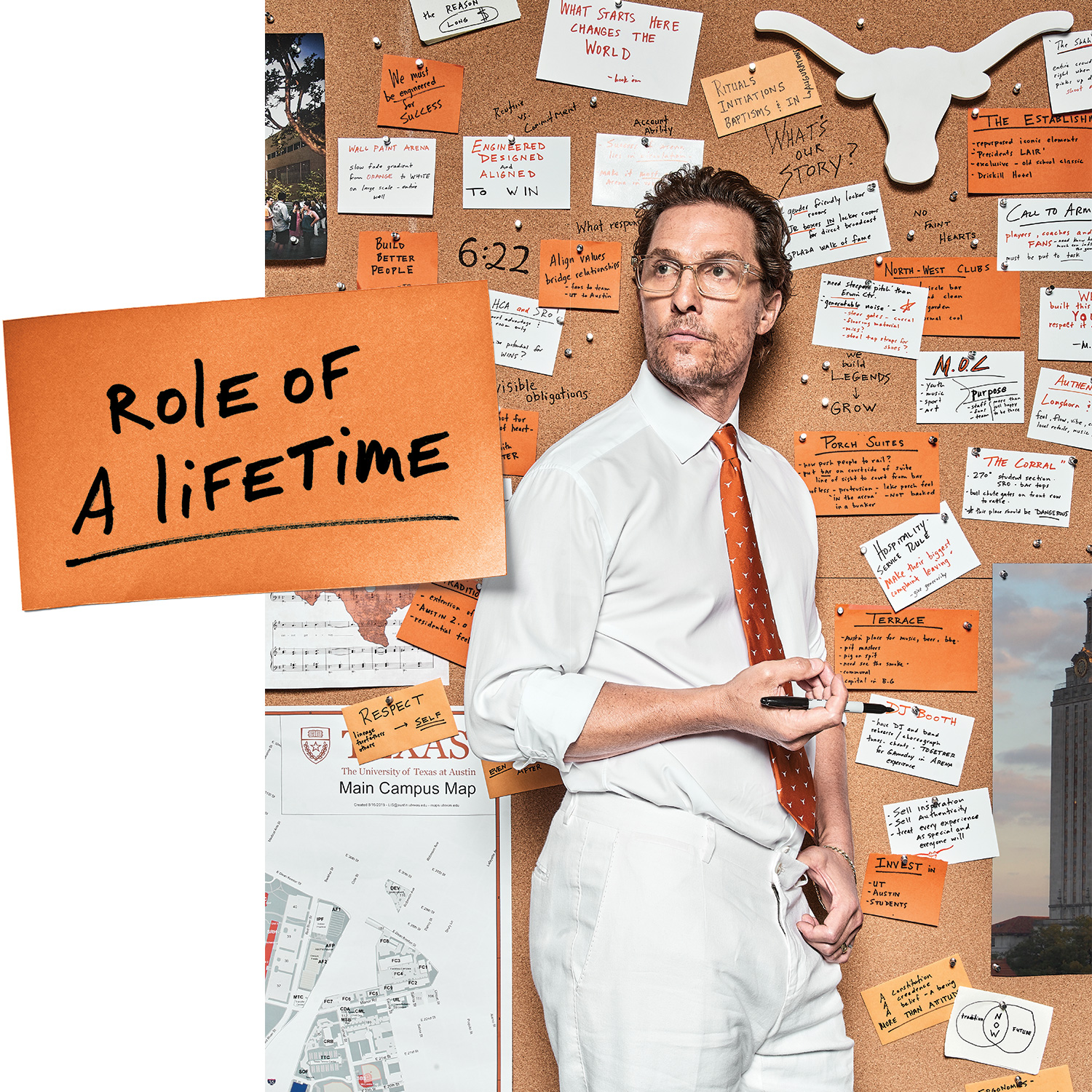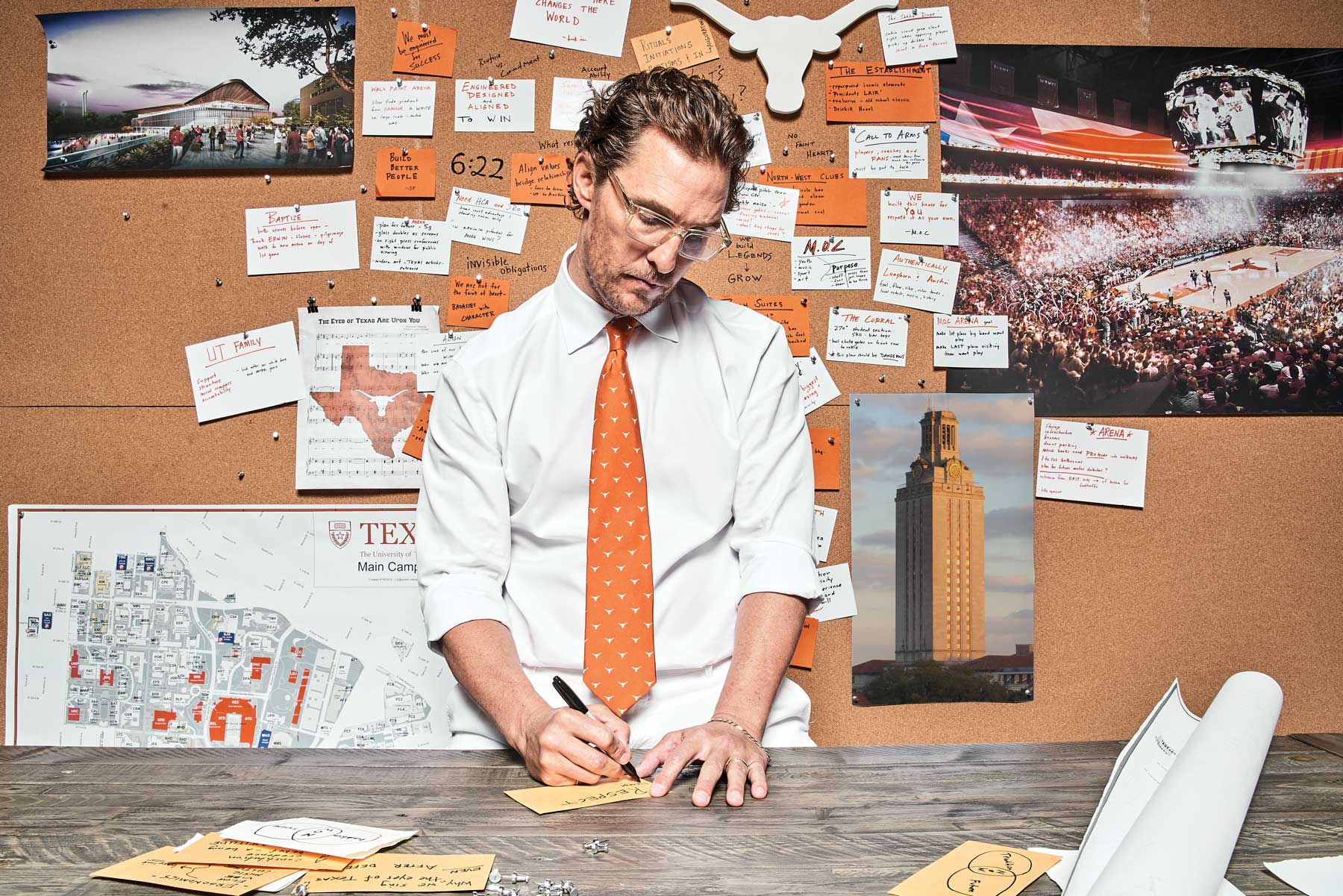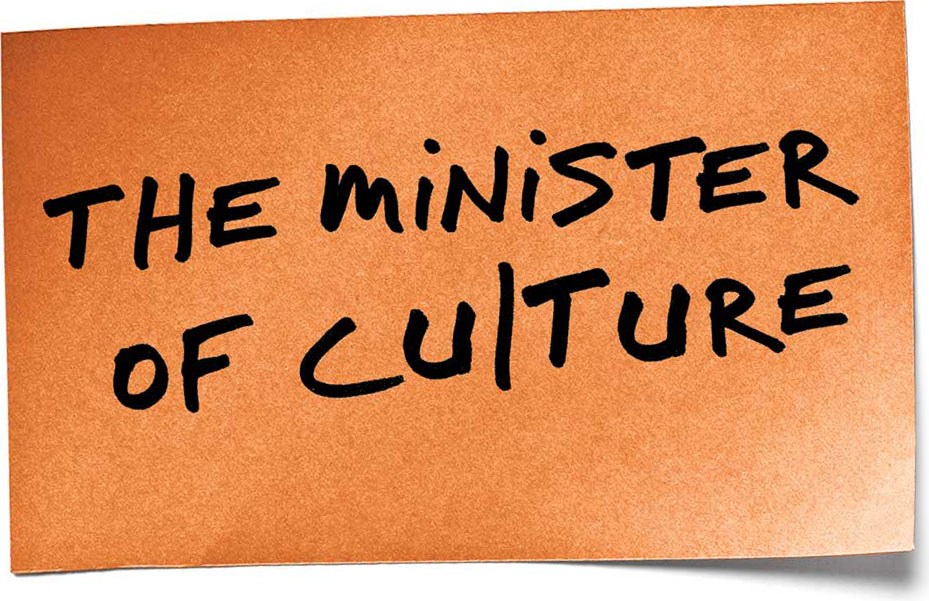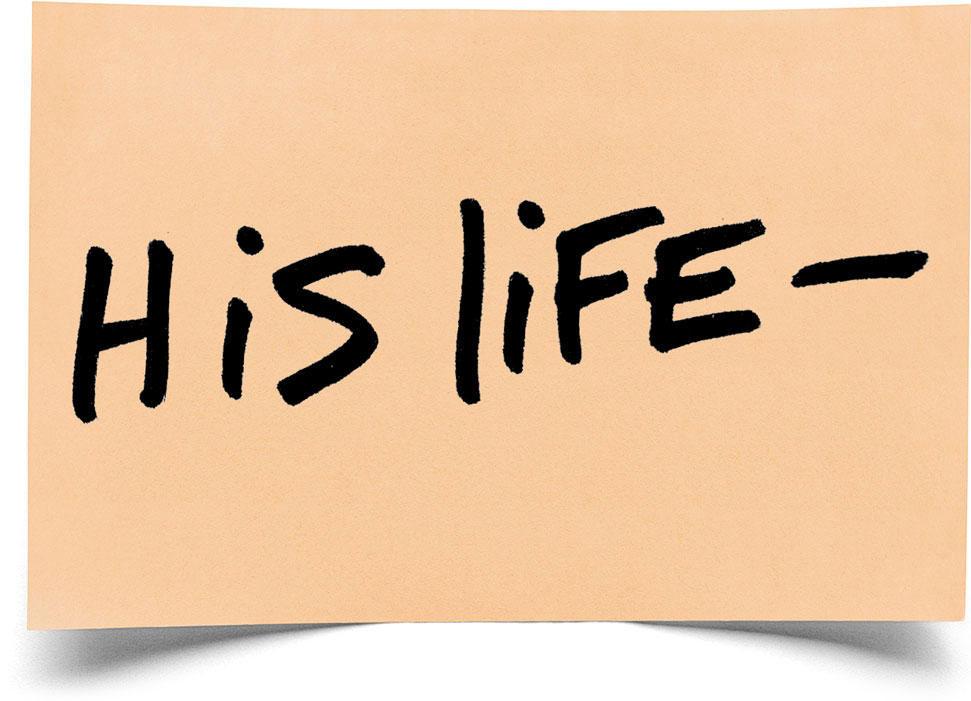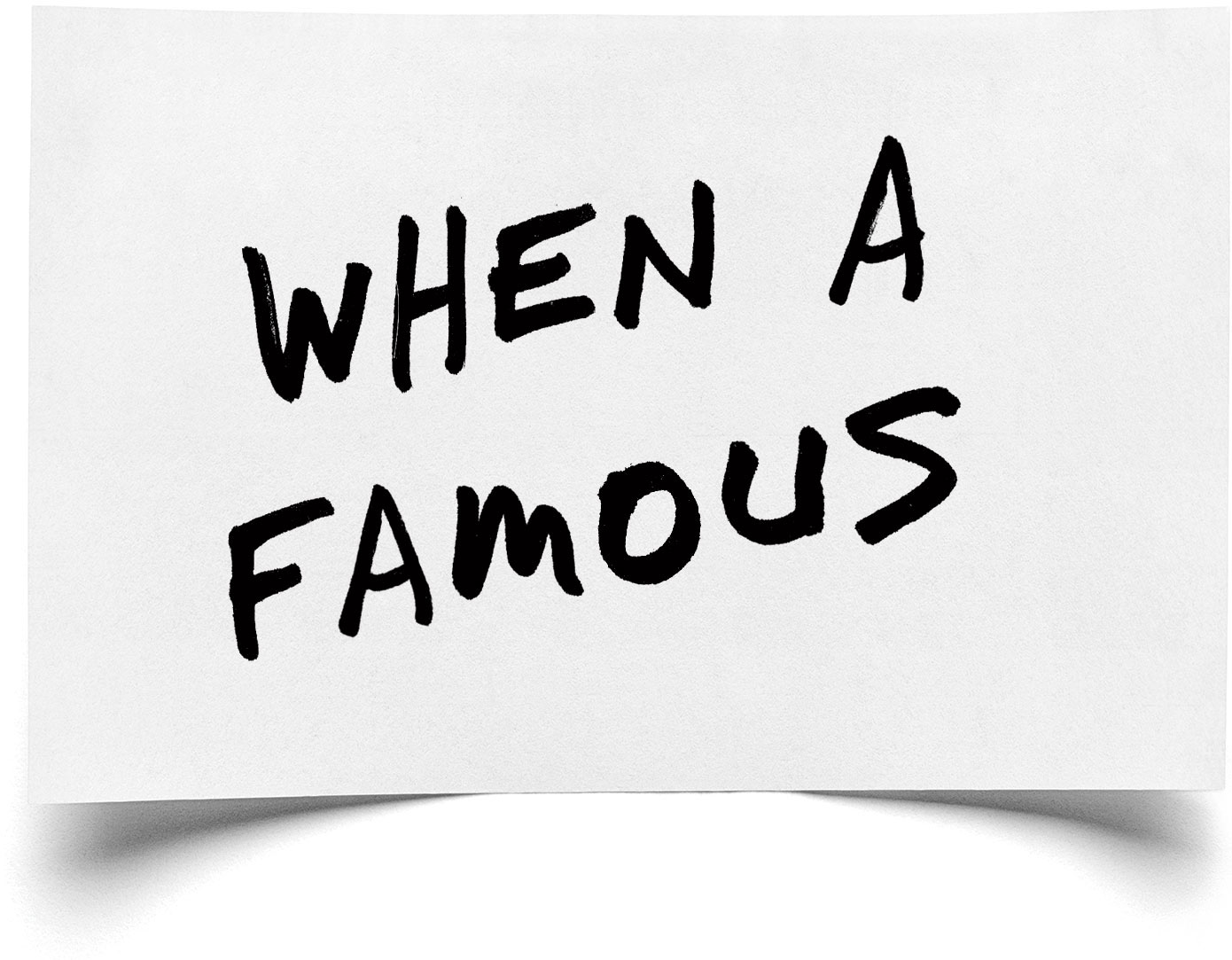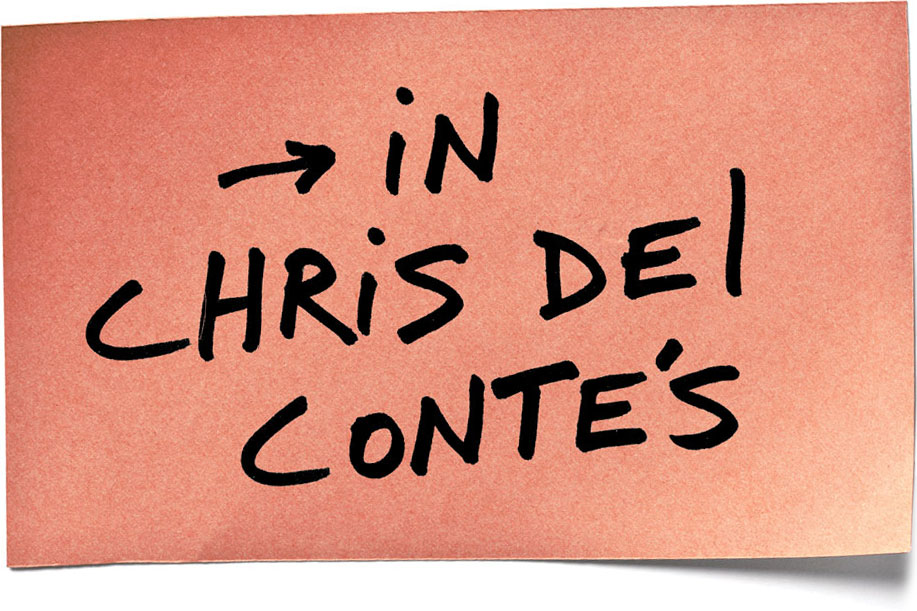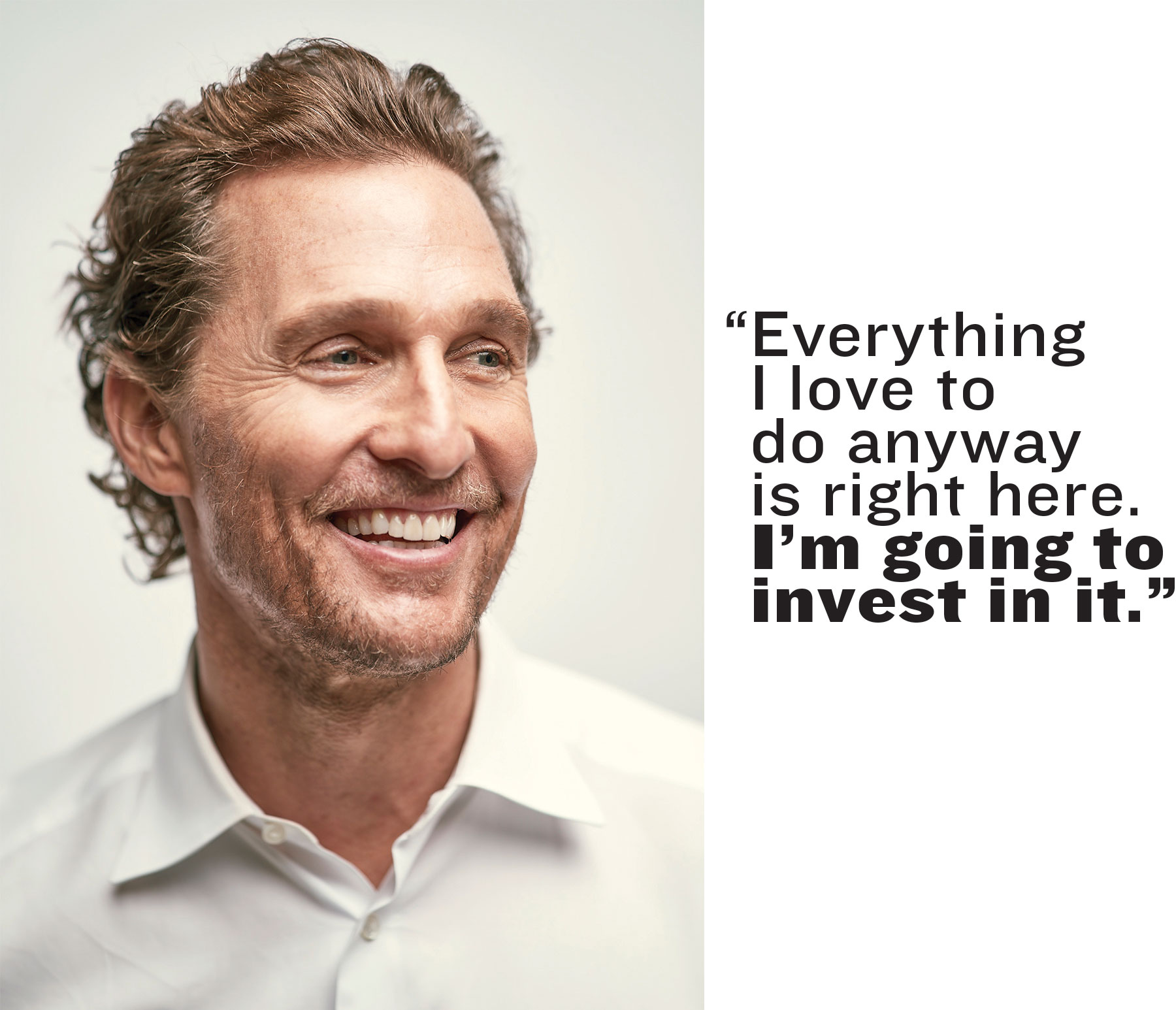From the November/December 2019 issue of the Alcalde
Matthew McConaughey’s love for UT is more than pride—it’s a calling.
By Chris O’Connell
Photographs by Matt Wright-Steel
KNOW WHAT TO EXPECT as I wait by the hostess stand at the West Lake Hills location of Sway, a chic, modern Thai restaurant with lemongrass-infused gin cocktails and curry so hot it will melt your tongue. A group of guys in slacks shuffle off to the valet stand as an A-list actor battles the even-at-midday Austin traffic. I feel like they should know who is about to arrive. They’d probably like to.
He walks in, sticker-covered MacBook under his arm—“just keep livin,” et al—looking every bit the handsome movie star who has chosen to live in the Texas Hill Country instead of Hollywood that he is. He wears a cuffed chambray shirt, unbuttoned to his mid-chest, and light blue shorts that fall just above his knee. It’s 100 degrees and rising, so, for that reason and because it’s on-brand, Matthew McConaughey wears flip-flops. Atop his head is a backward-turned white Yeti baseball cap, covering a mane of dark, wavy hair that falls to his neck and never seems to dry out. He’s tan, but that’s already a matter of public record.
McConaughey is greeted at the front door by a man who at first appears to be an eager fan but is the pastor of the nearby church he attends.
“Did you come here together?” McConaughey asks us both.
“No,” we answer in unison.
Professor McConaughey, BS ’93, Life Member, Distinguished Alumnus, Minister of Culture, and Academy Award-winning actor, glides between worlds. So it tracks that he might think the universe has conspired to bring a representative of his faith and of his beloved alma mater together.
The host finds an empty table for us to be alone. It’s normally clear within seconds of sitting down in public with a celebrity if people are going to be, as they say, cool. Our waiter, who looks young enough to be an underclassman at said alma mater, nervously acknowledges that he knows he is about to serve Thai food to a Very Famous Person, and that he is also going to be as cool about it as he possibly can.
McConaughey’s concepts for Texas’ new basketball arena are inspired by the city and the university.
origin story has been told many times now, specifically that McConaughey seemed to pull the title out of nowhere in a meeting, and that it just stuck. That would fit the impression many people have. He has that rare form of charisma that sends his quips and one-liners straight to the zeitgeist.
I ask him about the name for his new role, already known colloquially as simply M.O.C. How does one arrive at such a moniker?
He spends the next 20 minutes answering my question in between bites of a green papaya salad with dried shrimp on top. Unless you’ve been living under Billy Goat Hill—may it rest in peace—you’ve read some variation on the following anecdote: In the spring of 2018, UT Vice President and Athletics Director Chris Del Conte met with groups looking to partner with the university on a new arena to replace the Frank Erwin Center. McConaughey was there as part of a team with sports and entertainment development and investment company, Oak View Group (OVG), and music promoters C3 Presents and LiveNation. Everyone talked about their roles, and Del Conte asked McConaughey what his was, and thus, the Minister of Culture was born. Del Conte saw a perfect fit, and the group won the bid.
McConaughey will work on ideas including but not limited to suite designs, bar placement, color schemes (100 percent orange and white everywhere on gamedays, obviously), and other concepts, to create a symbiotic relationship between the arena, the city, and the university. He is quick to note that the arena has to feel like Austin—the Austin of right now, growing and dense and full of new opportunities—and the university at the same time. It should be the first place the biggest bands want to play and the last place a visiting team wants to play.
Of the title itself, he explains: “Ministers of Culture outside America are in charge of overseeing youth, sports, music, and tourism and culture. What a great thing to be in charge of. Culture has been my greatest educator.”
Wonderful, a nation of Longhorns replied when the news broke last year, but what does he get out of it?
“I’m about to turn 50, man. I’m not here to f--- around. I don’t choose s---, like, wouldn’t this be cool?” he says. “I’ve got a family, man. I’m choosing legacy: things that will pay me back on the inside, my own spirit, and pay my family back. Not cash. Things of value. That’s cultivation. That’s good culture.”
McConaughey, it seems, is taking stock of his life as he hits the half-century mark, trying to figure out if he likes what he sees.
This past spring, he sequestered himself in Fort Davis, Texas, to work on a writing project he isn’t ready to announce quite yet.
Why Fort Davis? “I was conceived there, actually,” McConaughey says with a sly smile. “I had to go back.”
we’ll skip the conception part—began on Nov. 4, 1969, smack dab in the middle of Texas’ famed national championship football season. McConaughey was born in Uvalde, Texas, and moved to Longview in 1980. Between high school and UT he spent some time in Australia. He brought back a faux Aussie accent to the Forty Acres his freshman year, he told Seth Meyers in 2016. “Were people into it?” Meyers asked McConaughey. “The ladies kind of were,” the actor responded.
The radio-television-film major also impressed a young director named Richard Linklater, who was making Dazed and Confused the summer before McConaughey’s senior year. Although not right away. The 23-year-old ran into casting director Don Phillips at a hotel bar, who, at 2:30 a.m., asked if he wanted an audition. McConaughey worked for two weeks on the part. Linklater remarked that McConaughey was “too handsome” for the role but McConaughey convinced the director he was right, saying “I ain’t this guy, but I know this guy.” He was eventually cast as the charming-if-lecherous townie David Wooderson, a bit part that ballooned as shooting progressed.
“I went to film school,” McConaughey says. “But the three weeks I had on set with Richard Linklater on Dazed and Confused, the practical experience I had? Shhhhh. Invaluable.”
His rise to bona fide leading man took less than three years after the film’s release. In quick succession, he appeared in A Time to Kill, Contact, and Amistad. McConaughey was living in Los Angeles, mainly, but made it back to UT frequently. His earliest high-profile sideline moments coincided with the hiring of head coach Mack Brown for the 1998 football season.
Following back-to-back losses to UCLA and Kansas State during Brown’s first year, then-SID Bill Little suggested Brown have McConaughey come speak to the team about how it was—no joke—a time to kill.
“Mack invited me in,” McConaughey says, sometimes before a huge underdog was coming to town, when players can be known to slack. “Mack would go, ‘Alright McConaughey, will you take the Rice game?’” he laughs.
“He is a symbol for Texas football on the sideline,” Brown says. “He was our guy, our go-to guy.”
The relationship has a clear parallel with Darrell K Royal and Willie Nelson’s—one, the straight-laced, masterful Texas coach, the other the freewheeling famous artist. McConaughey was on the sideline for many iconic games with Brown, most notably the 2006 BCS National Championship at the Rose Bowl, which McConaughey says he was physically sore from after, due to how tense and dramatic it was.
It was around this time that he began his journey from what he calls “the unscripted mascot for the city and the university” to an actual UT employee who is actively involved in both.
It’s easy to connect the dots. McConaughey doesn’t see himself as the caricature he’s been made out to be; all catchphrase and chest-thumping and artifice. Thus, the trip to Fort Davis.
“I need two weeks to sit with McConaughey,” he says. “Who are we? Who have we been? Who are we becoming?”
person aligns himself with a brand, it’s easy to think of the relationship as purely transactional. As such, when the acronym M.O.C. became as ubiquitous around campus as RTF and DKR, and when Visiting Instructor McConaughey became Professor of Practice McConaughey, it was an international story, with many wondering how involved he’d actually be.
That’s because, for the last two decades, McConaughey has appeared to some merely as a sideline fixture, much like how Will Ferrell and Ashley Judd appear when USC and Kentucky, respectively, are playing. He made headlines earlier this year when, before a men’s basketball game against OU at the Frank Erwin Center, he gave a pep talk to the team. He spent the rest of the game in a burnt-orange suit on the end of the bench—except, of course, during timeouts, when he’d hover around the edge of the huddle.
Texas Men’s Basketball Coach Shaka Smart describes how it all came together. McConaughey was hanging around during shootaround, and Smart asked if he’d like to address the team before tipoff. “I thought you’d never ask,” McConaughey replied. But then he paced the court, trying to concoct his speech. He didn’t have a canned speech prepared.
“He was like, ‘I’m a little nervous,’” Smart says. “It was awesome. We live in this world where sometimes people are afraid to put themselves out there and be the true version of themselves. He doesn’t have that. He is willing to be himself and share who he is.”
In August, McConaughey spoke in front of every student-athlete at UT, plus their coaches, in the LBJ Auditorium. One of his first lines, after a quick call to song, was: “Are we going to win every game? No, we’re not.” Karen Aston, women’s basketball coach, appreciates his subversion of the typical Knute Rockne-type speech.
“It wasn’t just rah-rah. He wants the student-athletes to own being a student and a Longhorn,” she says. “He wanted it to resonate with them. I think it did. I think it did with all of us.”
Two weeks later, he spoke at the annual Moody College of Communication Town Hall to the faculty. It’s not a coincidence that he’s balancing the M.O.C. portion of his life with a re-dedication to film students at UT. It’s a pointed effort to show that his “Script to Screen” course, in which students get a behind-the-scenes look at how much a film changes from, well, script to screen, is as important as the new porches he envisions for the as-yet-unnamed new basketball arena.
“He is a member of the faculty. This is not symbolism. This is not a PR move,” Moody College Dean Jay Bernhardt tells me, bluntly. “This is an effort for him to get more engaged and for us to take advantage of the many talents he brings. And I think that I would expect, over the coming semesters and years, he’ll get even more involved.”
As such, McConaughey will appear each semester—the school does not publicize when or where, for obvious reasons—alongside some of his directors. Last spring, Harmony Korine, the director of 2019’s The Beach Bum, showed up. This fall, Jeff Nichols, who directed McConaughey in Mud, will make an appearance as the students study the 2012 drama. In September, the San Antonio Express-News reported that McConaughey will make $12,000 for each solo course he teaches, and $6,000 for ones taught with another professor, “comparable to others at his rank and experience within Moody College,” a Moody representative told me. He will get a UT email address and business cards. It’s official.
Though McConaughey hasn’t acted since the end of last year—in addition to his work at UT, he’s also one of four local owners of pro soccer team Austin FC—he knows the next great role will come. It always does. And besides, he likes what’s going on right now—what he calls “a documentary about his life without cameras or a crew.” He explains the many layers in making a film: the camera lens, the script, the director’s choices, the editor’s choices. “I’m enjoying getting rid of the filters right now,” he says. The raw performance, as he describes it, is what he’s doing for the university.
“I’m in it, I’ve got my hands in the clay, man,” he says. “It’s right in front of me.”
office, the AD has a few spiral bound books with architectural designs for UT’s new, $338 million, 10,000 capacity (up to 15,000 for non-basketball events) arena set to open in the fall of 2021—including several that come from McConaughey. The M.O.C. has spent the last year or so visiting different arenas around the world for inspiration—the O2 in London; FedEx Field in Arlington, Virginia, where the NFL’s Redskins play; and the recently opened Chase Center, the new home of the Golden State Warriors—and has implemented some ideas.
“He has a very active role not only in design but concept,” Del Conte says. “He’s going to come in and say, ‘Hey, these are the kinds of things that resonate with Austin.’”
Del Conte shows me the porches that McConaughey has dreamed up as suites. They’re wooden and open-air, with swing gates—like lake porches—and there’s ample room to high-five your neighbor. McConaughey says that’s because he believes in the communal experience of Austinites watching something live, like Texas basketball or their favorite band. And those bars in the suites? He has an idea to move those to cut away from distractions during a live event.
“How does the game on the floor become the only game in town ?” he asks, rhetorically. The M.O.C. knows the answer. “It’s engineering to create engagement and intimacy.”
Part of that engineering is what he plans to do to enhance the student experience at games, and using the student section to create a real home-court advantage for the Longhorns. He’s cagey on what exactly that looks like, but he invokes Duke’s Cameron Indoor Stadium, probably the most intimidating arena for a visiting basketball team. Along the arena’s lower bowl resides the Cameron Crazies, the most infamous student section in sports, known to stand most of the game, scream incessantly when the opponent has the ball, and chant in unison at certain points.
“I don’t want to tell you because I don’t want to let it out of the bag, but where I’ve brought up we’re gonna put the students, it’s standing and it’s going to be a raucous … if it’s engineered right,” he says. “We’ve got ideas we are implementing in the design. Are they in a spot where they’re allowed to sit down? If you don’t give the option, what do you force? SRO. Standing room only. That’s worth a few points.”
The actual design of Cameron won’t work on the Forty Acres, specifically because the new arena must double as a concert venue, but McConaughey is looking to nab certain elements of the field house—as he is with other arenas around the world—to take the best of everything and make it quintessentially UT and Austin.
“Where are [the students] in the Erwin Center? Behind the basket,” he says, smiling devilishly. “You’ll see where I’ve got ’em.”
McConaughey also dreams of a color scheme that is nothing but burnt orange and white on nights that Texas men’s and women’s basketball play. He might even have a pitch for the sponsors. He hypothetically throws out a beer sponsor with non-UT colors. How can that be Texas-ified?
“I don’t know if we can pull this off, but with lighting, we can make that sign burnt orange and white for the night,” he says, his eyes widening. “For the concert, OK, original colors. I think on UT nights you’re selling your brand better when it’s our colors. You’re part of us, you’re rooting for us. It’s synchronicity.”
If McConaughey is, in his words, the unscripted mascot of the city and the university, the arena will be a reflection of his values, it would seem. But first, if McConaughey has it his way, there will be a ceremony for leaving the Frank Erwin Center.
The current arena has been derided as too big and outdated, with uncomfortable seating, crummy food, poor acoustics, and I swear I’m not piling on here but I polled a group of Longhorn diehards and was told that “the restroom locations are trash” and “every exit from the building is a unique experience (in a bad way).”
But the Frank Erwin Center, opened the week after Thanksgiving in 1977, has been an important home. Women’s basketball won all 13 in-season home games there in 1986, en route to becoming the first Division I basketball team to go undefeated for an entire season and win the NCAA Tournament. Kevin Durant and T.J. Ford and Mo Bamba and BMW stunned crowds at The Drum. Prince played his first-ever Austin concert inside, on his 98-show Purple Rain Tour in 1985. There’s a tradition there that McConaughey says he wants to acknowledge.
“We need to get a big group to go over and thank it for what it is and what it was and pay our respects, and then move over,” McConaughey says. “To make sure we’re not forgetting our lineage. People want to skip the line and visit the new joint. They don’t want to take care of the elders. There needs to be a transition there.”
He isn’t speaking figuratively. He wants to lead the procession.
Del Conte says they will break ground on the new arena, to be located where a parking lot currently sits south of Mike A. Myers Stadium, on Dec. 1, 2019. Texas Athletics has to wait until home football games are over, because that parking lot is needed until a 60-foot hole is put into the ground. I tell Del Conte that an alumnus once told me that the cranes around campus have been up since he was in school more than 50 years ago and have seemingly never left. Del Conte says that if you don’t see a crane up on a campus, that campus is not seeking to improve.
“I’m a firm believer, if you use 1950s Bunsen burners to teach chemistry, you’re going to get a 1950s chemist. You have to constantly evolve, build, re-do, and invest,” he says. “That’s one of Matthew’s big comments, too. At the height or peak of your success are you looking to reinvest or take out?”
McConaughey is ready to invest. “Myself, my time,” he tells me at lunch. “Everything I love to do anyway is right here, I’m going to invest in it.”
Nine years ago, McConaughey punted his life into the rafters. He and his wife, the Brazilian-born model and designer Camila Alves, moved to Austin to raise their first child, a son named Levi (they have since had two more: a daughter, Vida, and a son, Livingston). Though they keep a home in Los Angeles, he joined a tradition of movie-makers who have largely spurned Hollywood for Austin, sharing a city with Linklater, Terrence Malick, and Robert Rodriguez. He also took a right turn in his career, which to that point had mainly consisted of starring as the romantic foil in movies like The Wedding Planner, How to Lose a Guy in 10 Days, and Failure to Launch. He called up his accountant, asked if his money was right (it was), and decided that he was only taking roles that he truly cared about. Thus began what is now known as “the McConniassance”: working with William Friedkin, Jeff Nichols, and a reunion with Linklater in lower-budget, grittier, so-called art films.
He let people run with the McConnaissance thing. Yes, he admits, he literally told himself, “No more rom-coms,” but life is easily demarcated by points on a timeline, which was the narrative about McConaughey. He used to be one guy; now he’s another guy.
“It looked like a jacknife, right angle [from] romantic comedies, shirtless guy on the beach,” he says. “But I worked just as hard to prepare doing those movies as I did doing this dramatic art run.”
The shift came when he realized the movies he was making were less interesting than what he was experiencing off-camera.
“I laugh harder, cry harder, smile bigger, feel more joy in my real life. I thought, let’s pick some characters that challenge the vitality that I’m feeling in my life. I can be more of myself.”
There’s a (perhaps valid) notion that McConaughey is a lot like his characters. Bernhardt, the Moody College dean, says he is exactly like who we see on TV. He’s mainly speaking of the energy he brings to the classroom; McConaughey generally chooses to play characters with some combination of intensity, focus, and charm. Del Conte tells me that before he really got to know McConaughey he could not separate the actor from Wooderson. “You underestimate him,” he says.
Brown says the free-spirit thing is not a bit, either. On the sideline of a Texas game, McConaughey once told Brown’s wife Sally that the family was going to get in a van and just drive north.
“Where are you going?” she asked. “Don’t know,” he told her. “How far are you going to go?” she replied. “We’re going to go as far as we are going to go, then we’re going to turn around.” he said.
“That’s Matthew,” Brown says, noting that McConaughey was one of the first calls and texts the now-North Carolina coach got after his first win in Chapel Hill this August. “He is very passionate about his friends. If I called him right now he would call me right back and help with anything.”
Of course, the old yarn is that the part of Wooderson in Dazed and Confused was written for McConaughey based on how he auditioned. To wit, McConaughey, without planning it (as best I can tell), literally uses a famous Wooderson line in conversation with me. We’re talking about why he likes to speak to the players, and what he gets out of edifying before them.
“As I’ve gotten older,” he says, my eyes widening. He’s not going to say it, is he? “They’ve stayed the same age,” he continues, and—in my heart of hearts—just then genuinely realizes what he has done. “It’s a very Wooderson line, really,” he quips, before letting out a huge laugh.
Is he like Rust Cohle, the grizzled ex-detective from season one of True Detective? Well, no. He did not crack one Lonestar tallboy during our lunch, and his hair is much nicer. Also this is real life. But the famous “time is a flat circle” line from True Detective—an echo of the Nietzschean idea of endless repetition across the universe—is a few mustache hairs away from the very real McConaughey philosophy.
Cohle speaks of the flat circle in fatalistic terms; why do anything if we’ve already done everything? This is where McConaughey diverges. Everything is interlinked—the city, the university, the state—and the relationship between the three is symbiotic, each giving and receiving life from the other two. It’s his job—and our job, too—to always try to enhance the relationship.
As we finish lunch, he explains what this all means to him. Austin has an identity problem right now; the city is stuck between two worlds, the hippie-dippie town and the bustling metropolis. But being who he is, and with his new affiliations, he can help.
“The blueberry in the tomato soup,”—he’s recalling a Rick Perry-ism from 2014—“There’s the capital. This youth has been pulling at this traditional backbone. It’s red. That’s good! We’re aggressively centric. That’s where my politics lie. Come on, man!” he says, I think to me, but perhaps to all one million Austinites. “It’s all right here, stay vital. It’s a beautiful dance. It’s as vital as any place on the planet. We need to be looking at it from the inside out.”
When we meet, it’s three days before the LSU matchup and the first time College Gameday has been on campus in 10 years. As Minister of Culture, he has been asked to ride into the live show on a horse. (He later nixed the idea for a different entrance that went viral, cruising onto set in a vintage Lincoln with longhorn steer horns affixed to the hood, blasting “Slow Ride” by Foghat.)
“My feeling is, shouldn’t a longhorn be the only four-legged animal on campus?” he says, surely realizing both its absurdity and the fact that he’s the only person in the world who could have a job like this. “I don’t know though. It’s pretty sweet.” Then he walks back to his white Lincoln SUV and drives off. He’s going shopping for a new hat.
Stories like these are supported by membership in the Texas Exes.
Join today to receive the bimonthly Alcalde magazine, and help keep alumni connected to UT.
